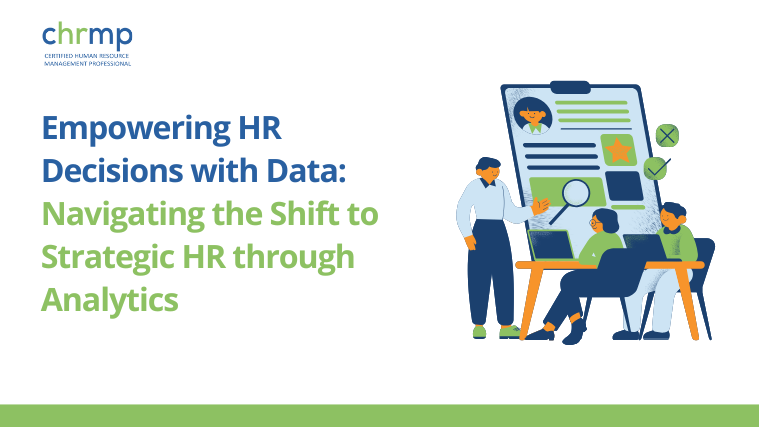

In the dynamic world of human resources (HR), embracing HR Analytics in HRM | Empowering Strategic HR Decisions has emerged as a pivotal strategy for fostering strategic decision-making and boosting operational effectiveness. This guide aims to clarify the concept of HR analytics, highlighting its significance, practical applications, and ways to acquire expertise via training and certification. HR analytics empowers professionals to navigate complex workplace challenges with data-driven solutions that resonate with the broader objectives of their organizations..
The shift of HR from an administrative function to a vital strategic partner marks a significant transformation in the business world. This shift is propelled by the integration of competency-based HR practices, the HR Business Partner (HRBP) model, and the deliberate use of data-driven strategies facilitated by HR analytics. As HR solidifies its status as a foundational element of organizational strategy, the critical role of HR analytics is underscored, enabling HR professionals to evolve from task performers to strategic architects
At its essence, HR analytics is the catalyst for HR’s transformation into a strategic function. It involves the meticulous collection, analysis, and application of employee data to enhance HR operations and, consequently, improve the organization’s overall performance. HR analytics transcends simple data examination, embodying the strategic employment of data to extract insights on workforce dynamics, forecast upcoming trends, and make informed decisions that boost employee satisfaction and productivity.
HR analytics underpins the transformation of HR into a solution-oriented function, facilitating strategic talent management, enhanced decision-making, and proactive problem-solving. This shift is evident in its application across various HR functions, including talent acquisition, performance management, and employee engagement.
The HR analytics framework comprises four stages—descriptive, diagnostic, predictive, and prescriptive analytics—each providing a depth of insight crucial for effectively leveraging data in HR:
The transformational journey of HR analytics can be best illustrated through a comprehensive example that showcases how an organization can navigate from descriptive to prescriptive analytics, solving complex HR challenges along the way.
Organization Challenge-: A multinational retail corporation was facing significant challenges with employee retention, particularly among its sales staff. The high turnover rate was impacting its bottom line through increased recruitment costs and lost sales opportunities.
Application: Finally, with prescriptive analytics, the HR team developed targeted interventions to reduce turnover among the identified high-risk group. This included the creation of a comprehensive onboarding program for new sales staff, enhanced career development paths, and training for managers on supporting employee growth.
Outcome: Within a year of implementing these strategies, the company saw a marked reduction in turnover rates among the targeted sales staff group, leading to cost savings on recruitment and training, as well as improved sales performance due to greater employee stability and engagement.
This example demonstrates the power of moving through the four stages of HR analytics. Starting with understanding what has happened (descriptive analytics) and why it has happened (diagnostic analytics), the HR team could predict future trends (predictive analytics) and develop strategies to address these proactively (prescriptive analytics).
By effectively leveraging HR analytics, the organization not only solved a critical HR challenge but also enhanced its operational efficiency and competitive edge in the market. This strategic approach underscores the potential of HR analytics to transform challenges into opportunities for growth and improvement.
HR analytics’ transformative power shines in addressing organizational challenges:
Optimizing Talent Acquisition-: Analytics identifies effective recruitment channels, predicts candidate success, and underscores factors influencing employee loyalty.
Refining Performance Management-: Insights from HR analytics help tailor training programs and set realistic performance goals, nurturing a high-performance culture.
Boosting Employee Engagement-: Analysis of employee feedback reveals key engagement drivers, leading to initiatives that enhance job satisfaction and loyalty.
The importance of HR analytics training is critical for HR professionals to navigate the complexities of strategic HR management effectively. Educational opportunities range from free courses providing an introduction to the field to advanced certification programs offering deep dives into complex topics. These programs prepare HR professionals with the analytical skills needed for strategic decision-making.
A multinational corporation implemented an HR analytics initiative targeting high employee turnover. Analysis of employee satisfaction, performance metrics, and exit interviews revealed patterns and causes of turnover. Targeted interventions, such as enhanced career development programs and leadership training, led to a notable reduction in turnover, yielding cost savings and heightened employee morale.
A medium-sized tech firm grappling with high absenteeism utilized HR analytics to identify underlying causes. Data showed higher absenteeism rates in departments with low engagement scores and in high-stress roles. Introducing flexible work arrangements, health and wellness programs, and engagement initiatives significantly curbed absenteeism, boosting productivity and well-being.
Training in HR analytics equips HR professionals with the necessary skills to interpret and leverage data effectively. A certificate in HR analytics or completing courses on HR analytics can significantly enhance an individual’s ability to understand complex data sets, apply analytical models, and communicate findings in a meaningful way. These courses often cover essential topics such as data collection methods, statistical analysis, predictive modeling, and visualization techniques.
The availability of both free HR analytics courses and paid programs makes it easier for HR professionals to find resources that match their learning pace and budget. Free courses offer a solid foundation for beginners, covering the basics of what HR analytics entails and how it can be applied. On the other hand, paid courses, including comprehensive HR analytics courses, often provide a more in-depth exploration of advanced topics, hands-on projects, and access to industry experts. These learning pathways ensure that individuals can acquire a robust understanding of HR analytics, regardless of their starting point.
The transition from traditional to strategic HR, fueled by competency-based practices, the HRBP model, and the strategic implementation of HR analytics, heralds a new era in HR management. HR analytics not only addresses current challenges but also anticipates future trends, aligning HR strategies with organizational goals.
This evolution transforms HR into a strategic powerhouse, highlighting the increasing importance of data-driven decision-making in achieving organizational success. Through education, training, and the practical application of HR analytics, HR is redefining its role, paving the way for a future where HR is not just a support function but a strategic partner driving business outcomes.

© 2007-2025 CHRMP| All Rights Reserved | Powered by Ripples Learning & Research Private Limited
